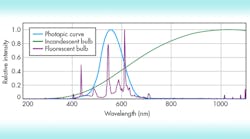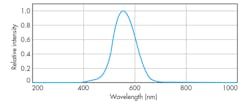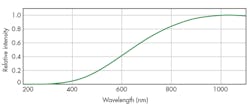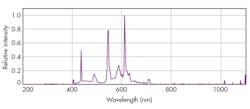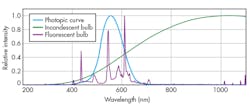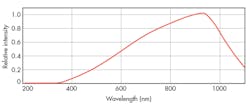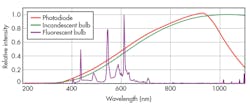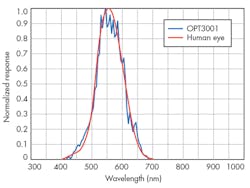Why Does Accuracy Matter So Much with an Ambient Light Sensor?
This file type includes high-resolution graphics and schematics when applicable.
The purpose of an ambient light sensor (ALS) is to allow electronic systems to “see” light like a human eye. The spectrum of the human eye is called the photoptic response. Matching the photopic response as closely as possible will improve the human-machine interaction, extend the life of the system, and improve system power utilization.
To understand why accuracy matters with an ALS, we first need to understand exactly the concept behind an ALS. An ALS is a light-sensing device that provides an electronic signal that’s proportional to the amount of light it senses. Specifically, the photopic response is of interest (Fig. 1).
So if this is how the eye sees light, why is it important for the ALS to closely match that ability? To answer this question, let’s look at the spectral response of two different light sources: a typical incandescent bulb (Fig. 2), and a typical fluorescent bulb (Fig. 3).
The amazing thing when we look at these two graphs is to understand that if you “integrate” each of the two curves with the photopic spectrum, the relative energy under the curve is the same. In other words, humans perceive both graphs as having equivalent outputs (Fig. 4). Note that these two source spectral responses are normalized and don’t represent the power output relative to one another.
If we compare the photopic response to that of a typical photodiode (Fig. 5), an electronic device converts the light energy into an electric signal. It’s clear that the photodiode sees light very differently than we do. However, if the two spectral curves are integrated with that of a typical photodiode, we see that the output energy “seen” is quite differently, too (Fig. 6).
With the typical photodiode shown, we see light-source variation of nearly 1500%. In other words, the photodiode sees the incandescent bulb as being almost 16 times brighter than the fluorescent bulb.
Why does this occur? Look at the spectral response of each of the devices involved. The incandescent bulb outputs significant amounts of energy in the near-IR and IR wavelengths (>700 nm), unlike the fluorescent bulb. The photodiode “sees” this wavelength, but the human eye does not. Therefore, an electronic device that uses a typical photodiode responds to disparate light sources very differently than a human.
Now that we understand how an ALS improves performance significantly versus that of a photodiode, let’s consider how close matching is really required. We already established that different types of light sources output very different spectral content, specifically in the area of IR light. One key to matching the human eye is to understand how well an ALS rejects IR energy. For example, the OPT3001 from Texas Instruments offers IR rejection of approximately 99% as shown in the datasheet (Fig. 7).
This results in less than a 4% error when comparing the response of the OPT3001 between typical fluorescent and incandescent bulbs (the photopic matching is claimed as amongst the best in the industry for this device). It’s critical to review the device’s datasheet to understand how well they match the photopic response. Key items to look for are the amount of IR leakage, a shift in the peak spectral response, or a narrowing of the spectral response.
ALS devices currently on the market have over 20% error when comparing their relative response to different illumination sources. This is an order of magnitude better than a standard photodiode as shown above, but it’s an order of magnitude worse than the best available ALS devices.
Human Experience Enhancements
Now that we see why an ambient light sensor offers significant improvements over a photodiode, the next question is how does this improvement affect our experiences? To answer this question, let’s look at a two use cases and discuss the experiential improvement offered by an ALS.
Mobile consumer electronics such as smartphones, tablets, ultrabooks, and other personal electronics have identified that varying lighting conditions require adjusting the screen’s backlight level to improve the user experience. This is accomplished with an ALS. However, non-consumer displays haven’t taken this into account until recently.
Consider today’s nearly ubiquitous smart thermostat, all of which have a small format display. At first blush, it seems that a thermostat mounted on an interior wall of your house or place of business doesn’t experience varying lighting conditions other than lights on/off.
What if the wall faces a window that faces east? In the morning on a sunny day, that wall will need to overcome a significant sunlight load that contains a high level of red and infrared light. In this case, the backlight needs to be turned up so that the display is readable in the high glare created by the sunlight. As the day progresses, the morning sun no longer causes that glare and the backlight needs to be turned down to prevent the display from washing out in a dimmer environment. This same thought process can be applied to a multitude of displays with similar varying lighting conditions, such as ATMs, movie-theatre ticket kiosks, and vehicle infotainment systems, to name a few.
Similarly, consider interior lighting in commercial buildings. Energy cost due to lighting is one of the largest expenses in commercial real estate (HVAC being the largest!). As buildings transition more to LED lighting rather than the more power-hungry fluorescent lights, or even worse incandescent lights, they’re already achieving savings.
Since it’s much easier to control the power consumption of LED lighting, you can save even more by what’s referred to as daylight harvesting.1,2 Daylight harvesting is simply using natural daylight to supplement artificial electronic lighting. This allows for energy savings while maintaining a “proper” light level within the defined area of usage. The target is to provide the proper lighting level for people to perform their defined tasks for the given area.
An ALS measures the naturally provided light and feeds this information to the controller, which in turn controls the artificial lighting level to allow the sum to meet the guidelines for the defined usage. What do I mean by the proper lighting level for the defined usage? Consider a library versus an average corporate cubicle farm. In the library, you will want brighter lights to make reading easier. The PC screens in the cubicle complex will drive a lower required lighting level to keep their backlight levels (and power consumption) down.
Enhanced Performance and Efficiency
In addition to the experiential improvement offered by using a more accurate ALS, system performance and efficiency improve as well. If we reconsider the same two examples discussed above, what system improvements can be expected?
Lowering the backlight level on a display will actually extend the life of the display. All displays (whether CRT, LCD, OLED, or PLASMA) have a “half-life.” The half-life or half-brightness is defined as the time it takes for the display’s brightness to degrade until it’s half that of the new display.3 The higher the backlight is driven, the faster the degradation.
Therefore, by managing the backlight level to a viewable level based on a ALS rather than what has historically been done, which is to keep the backlight at its maximum value, will extend the life of the display. For most portable consumer devices, this isn’t a big concern because usage of the device will be significantly less than the half-life. However, for many of the displays mentioned above (ATMs, ticket kiosks, thermostats, and so on), expected lifetime could be measured in decades. In this case, the half-life could become an issue.
Similarly, in a lighting system, the less power that’s applied, the longer the lifetime of the bulbs. We’re all probably familiar with the kilowatt-hour lifetime that appears on the packaging of light bulbs. This is simply a measurement of power over time. The less the average power is being applied due to dimming based on daylight harvesting, the longer before the bulb needs to be replaced, which reduces the luminary maintenance cost.
Summary
As you can see, how well an ALS matches the photopic response is critical to maximizing the human-machine interaction, extending the life of the system, and improving system power utilization. Devices with improved photopic response, like the OPT3001, are available for many industrial ALS applications.
References
2. Title 24 — California Energy Commission — State of California
3. Geoffry Morrison, "How long do TVs last?," CNET Morrison’s Mailbag, February 23, 2012.
Further reading:
Backlight and Smart Lighting Control by Ambient Light and Proximity Sensor Reference Design, TI Design (TIDA-00373), March 2015.
